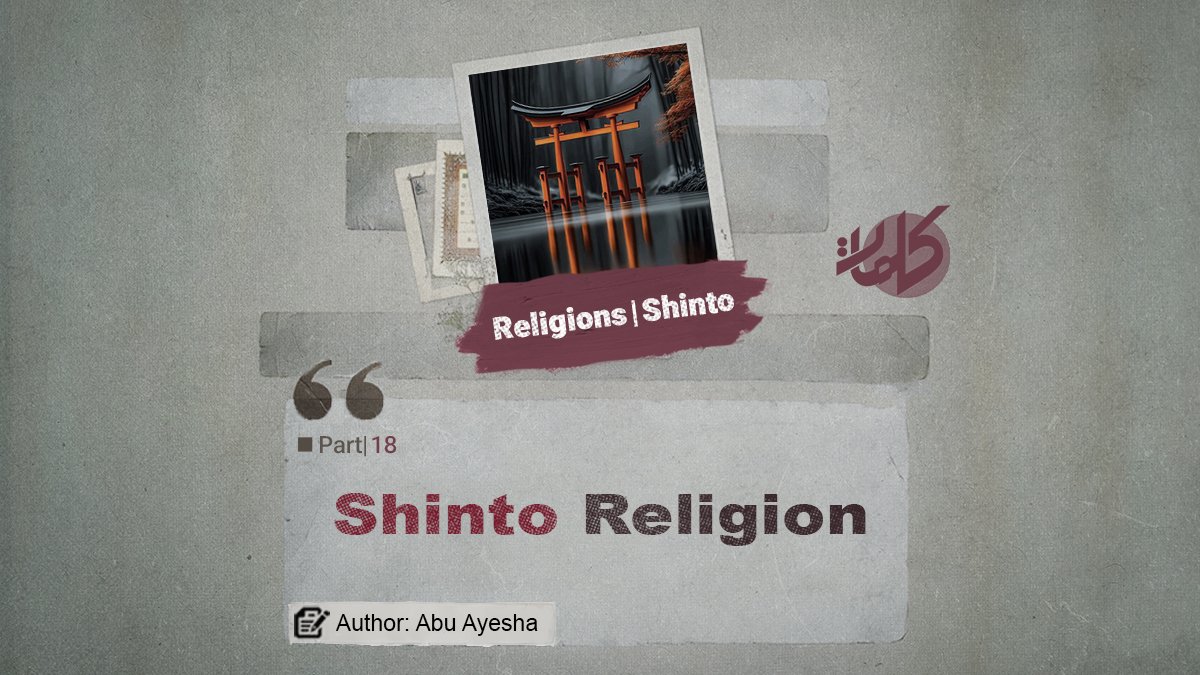Author: Abu Ayesha
Shinto Religion (Part 18)
Historical Overview of Shinto Religion
Shinto, as the indigenous religion of the Japanese, has played a significant role for centuries in shaping the country’s cultural, social, and political landscape. [1]
Brief explanations were provided regarding the Jomon and Yayoi periods, whose dates are cited differently by various sources. The Kofun period (300–710 CE) marked the emergence of Japan as a unified nation. During this era, the first and most important shrines of the main Shinto tradition—namely the Ise Shrine and the Izumo Shrine—were established.
The recognition of Buddhism around 538 CE, followed by its rapid development, contributed to the systematization of Shinto. Although Buddhism and Shinto continued to merge, many sought to distinguish the ancient beliefs from imported religions. As a result, Shinto evolved into a more structured belief system. On the other hand, Confucianism, which had entered Japan earlier than Buddhism, was another foreign element that required regulation. During the Nara (710–794 CE) and Heian (794–1185 CE) periods, Shinto solidified as a system and maintained ongoing, dynamic interactions with other religious and philosophical systems across Asia.[2]
After state intervention in Shinto affairs was reduced, the religion took on a purely spiritual and religious form, attracting the genuine interest and faith of the people. In every home and household, a central shrine, called a Kami-dana, was established. In this special chamber, wooden or paper plaques bearing the names of ancestors or local deities were placed. Sometimes depictions of the sun goddess Amaterasu or the deity of rice Inari were added. A sacred mirror was often present, and other boards featured religious prayers adorned with talismans and sacred symbols.
As European ideas began to influence Japan, Shinto was the first to be affected. People gradually distanced themselves from the official shrines established by the state. Efforts by devout Buddhists to preserve their faith, along with attempts by Christians to revive their near-extinct religion, created religious sentiments and debates that threatened Shinto beliefs. This movement was particularly strong among young people studying Western sciences at universities, who criticized and challenged the religious beliefs of their ancestors. Atheism, irreligion, and skepticism grew rapidly; by the early 20th century, a survey of Tokyo University students revealed that among 4,600 students, 2,980 identified as Gnostic, 1,511 as completely irreligious, and 118 as Christian, Buddhist, or Shinto adherents. These figures reflected the growing influence of secularism and disbelief among Japanese youth.[3]
Until the end of World War I, Shinto as practiced in official shrines was the state religion of Japan. The central tenet of this sect was the divine rule of the emperor, who was considered a descendant of the great goddess Amaterasu. Every Japanese was expected to submit to his sacred will. The emperor’s palace was regarded as a holy place, and the tombs of deceased emperors became pilgrimage sites.
The definitive abolition of Shinto as a state religion was established in Article 20 of the Japanese Constitution, published on November 3, 1948: “Freedom of religion shall be guaranteed to all. No religious organization shall receive privileges from the state, nor exercise political authority. No person shall be compelled to participate in religious acts, ceremonies, or duties. The state and its organs shall refrain from religious education or any other religious activity.” [4]
In December 1945, the Shinto Directive separated religion and state, guaranteeing religious freedom in Japan. On New Year’s Day 1946, Emperor Hirohito issued the Humanity Declaration, denying the myth that he was a living Kami. On February 2, 1946, the SCAP (Supreme Commander for the Allied Powers) dissolved the Shinto Council, ending eighty years of state Shinto. The religious freedom that followed gave rise to numerous new religious movements, a period referred to as the “Era of Crowded Gods,” which continued until the 1950s. In 1956, 80,000 shrines out of approximately 110,000 formed a coalition called the Shinto Shrine Association, headed by the Ise Shrine, to preserve Shinto. The arrival and establishment of Christianity, along with Japan’s economic development and technological advancement, altered religious beliefs; yet the roots of Japanese belief have not disappeared.[5]
Note: Although Shinto once flourished under government support and expanded its followers, with teachings enforced in schools and children introduced to the religion from an early age, it gradually lost its prominence and became a sect. This occurred when politicians perceived that Shinto might constrain their policies. The imperial government, established after the Meiji Restoration of 1868, had used Shinto as a political ideology to legitimize the state. Following Japan’s surrender in 1945 and the collapse of the imperial system, the political dominance of Shinto ended, pushing it once more to the margins. Nevertheless, Shinto continues to survive among the Japanese as a set of folk beliefs.
Today, most Japanese, particularly the educated class, do not hold strong religious beliefs. Research shows that most Japanese are not committed to any religion and are largely secular or irreligious. Historically, religion played a prominent role in everyday life, with Shinto and Buddhism each serving as official religions at different periods. However, since the Japanese Constitution of 1947, secularism has been a defining feature of society. No single religion dominates, and Japanese people follow a mixture of various religious practices.[6]
According to a 2015 survey by the Gallup International Institute, Japan ranks second after China in terms of irreligion. Approximately 31% of the population is atheist or irreligious, and 57% do not identify with any religion.[7] National surveys of Japanese character, conducted every five years by the Japan Statistical Institute, ask respondents whether they hold religious beliefs. In the 2018 survey, only 26% affirmed having a religion, while 76% reported having none.[8]
This demonstrates the fate of any religion that cannot provide a clear, organized program for the happiness and well-being of its followers. Over time, people turn away and distance themselves from it. It is also important to note that, while internal factors contributed most to Shinto’s decline, external influences—particularly interventions by Western colonial powers—also played a role.
Continues…
Previous Part
References:
[1] Soltani, Muhammad, Analysis of the Influence of Shinto on Japan’s Foreign Policy from a Constructivist Perspective, 1403 HS, p. 2.
[2] Farahbakhsh, Ali, Shinto Religion: National Beliefs as a Form of Religion, Human Sciences and Cultural Studies Journal, Vol. 4, No. 3–4, 1385 HS, p. 63.
[3] John Nas, Comprehensive History of Religions, translated by Ali Asghar Hikmat, 3rd edition, 1354 HS, pp. 286–287.
[4] “Multiple Sects of Shinto,” Islamic Encyclopedia Tahoor.
[5] Farahbakhsh, Ali, Shinto Religion: National Beliefs as a Form of Religion, ibid., p. 66.
[6] Sowunway Tribe website, article: Religion in Japan, 1404 HS.
[7] Daddoush, Ahmad, Shinto Religion… A Mythical Heritage Telling the Story of Japan from Its Origins to Surrender, Al Jazeera, 2024/10/20.
[8] Ajam, Dr. Muhammad, The Place and Importance of Deceptive and Religious Sects in Japan, International Peace Studies Center.



